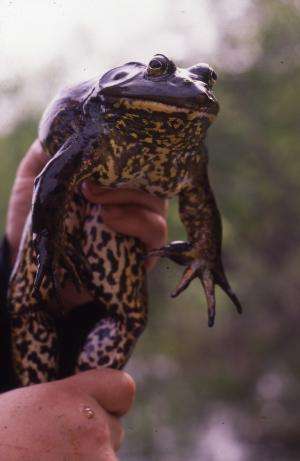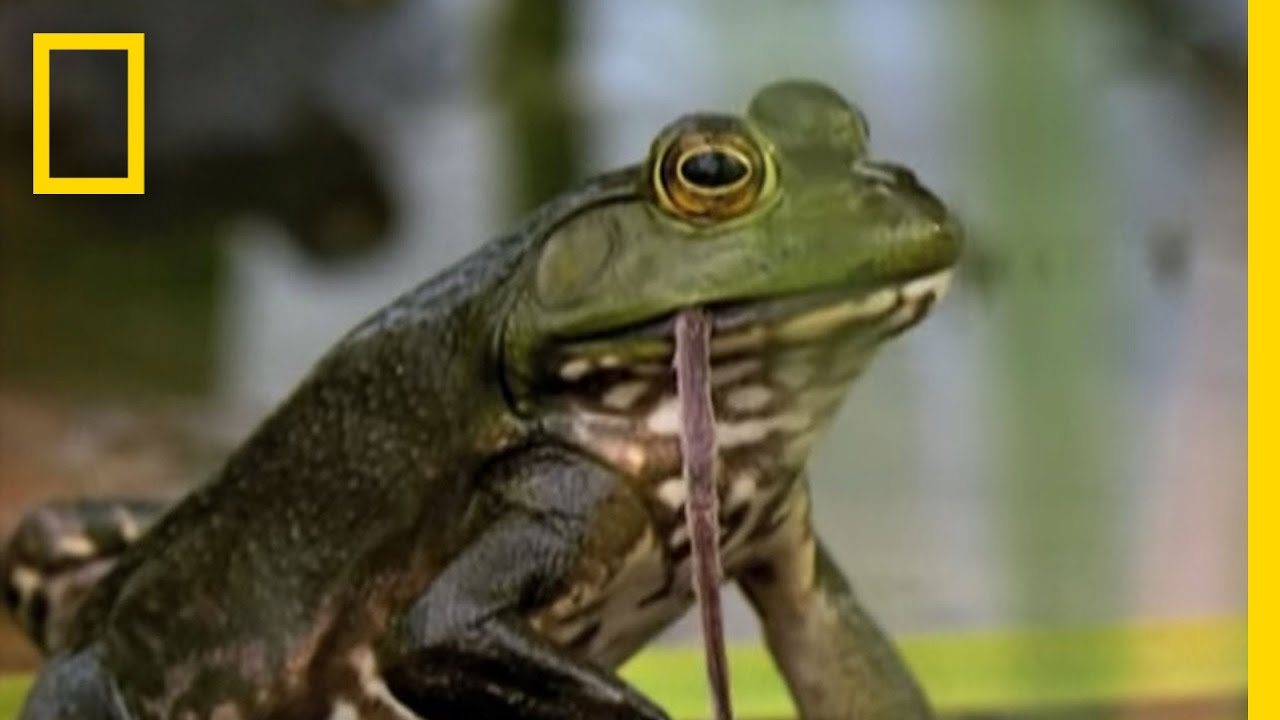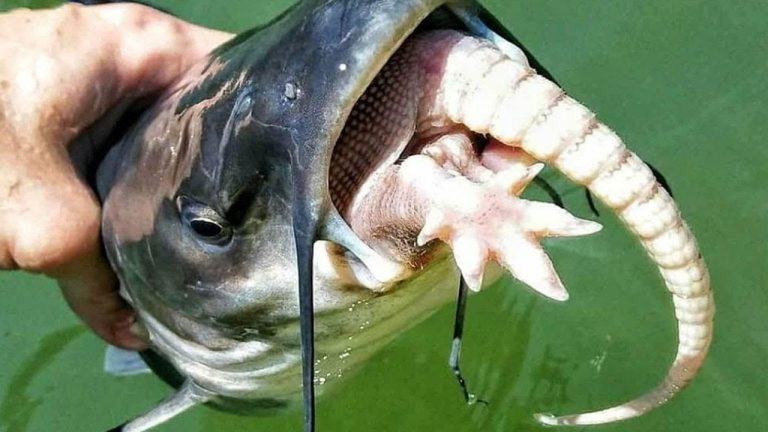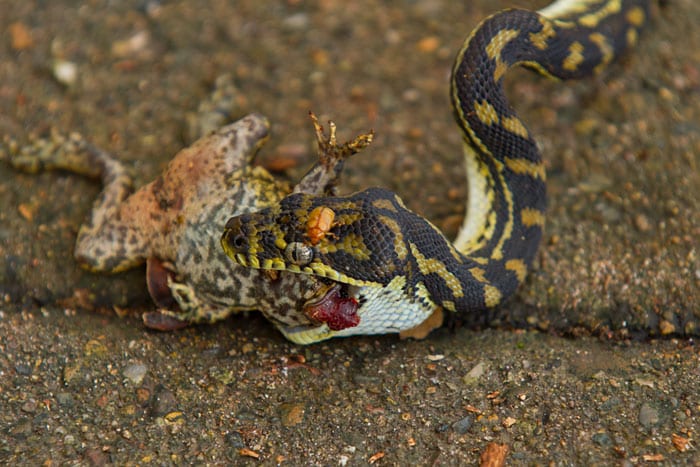What Do American Bullfrogs Eat
The American bullfrog (Lithobates catesbeianus) is a large frog that is found in North America. It is the largest frog in the continent and can grow up to 20 cm (8 inches) in length. The adult frog has a green body with brown spots and a white belly.
The hind legs are long and muscular, which helps the frog to make great leaps. The American bullfrog is an excellent swimmer and can often be seen swimming in ponds and lakes.
The diet of the American bullfrog consists mostly of insects, such as crickets, beetles, flies, and grasshoppers.
They will also eat other small animals, such as snakes, mice, and lizards. In captivity, they will even eat pet food and human food.
If you’re wondering what American bullfrogs eat, the answer is a variety of things. Their diet consists of insects, small mammals, reptiles, and amphibians. In some cases, they’ve even been known to eat birds.
American bullfrogs are opportunistic feeders, which means they’ll pretty much eat anything they can get their hands on. This makes them one of the most successful species of frogs in North America. They’re also one of the largest species of frogs in the world, which gives them an advantage when it comes to hunting for food.
One thing to keep in mind if you’re thinking about keeping an American bullfrog as a pet is that they require a lot of food. So be prepared to provide them with a steady supply of insects or other small animals if you decide to take one home with you.

Credit: phys.org
What are Bullfrogs Favorite Food?
Bullfrogs are carnivorous animals and their diet consists mainly of small insects, spiders, snails, and other invertebrates. Occasionally, they will also eat small vertebrates such as snakes, lizards, mice, and birds.
Their powerful jaws and long tongues help them capture prey easily.
They will often sit and wait for their prey to come close before striking. Bullfrogs have been known to eat up to 1/3 of their body weight in a single day!
Can You Keep American Bullfrogs As Pets?
Yes, you can keep American bullfrogs as pets. They are a popular choice for amphibian enthusiasts because they are relatively easy to care for and their large size makes them fun to watch. American bullfrogs require a large enclosure with plenty of hiding spots and a shallow water area for swimming.
They should be fed a diet of live insects and other small animals. American bullfrogs can be aggressive, so it is important to choose tank mates carefully.
Do American Bullfrogs Eat Mice?
American bullfrogs are voracious eaters and will consume anything they can fit into their mouths. This includes mammals, such as mice. In fact, studies have shown that American bullfrogs are one of the main predators of house mice in some areas.
While they will eat just about anything, their preferred food items are crayfish, insects, and other amphibians. So while they will certainly eat mice if given the opportunity, it’s not their first choice.
What Do Bullfrogs Eat in a Pond?
A bullfrog’s diet in a pond typically consists of smaller fish, tadpoles, frogs, snakes, salamanders, crayfish, insects, and snails. They will also eat just about anything else they can fit into their mouths!
Bullfrogs are opportunistic feeders and their diet varies depending on what is available to them.
In the wild, their diet revolves around whatever prey is most abundant at the time. If there are lots of small fish in the pond, the bullfrog will eat mostly fish. If there are not many fish but plenty of insects or other invertebrates, then that’s what they’ll feast on instead.
In captivity however, where food is more plentiful and consistent, bullfrogs can become quite picky eaters. They may only want to eat one type of food item and refuse all others even if they’re starving. This is why it’s important to provide a variety of foods when keeping bullfrogs as pets so that they get the nutrients they need and don’t go into malnourishment.
Bullfrogs Eat Everything | National Geographic
Why are American Bullfrogs Invasive
American bullfrogs are considered to be one of the most invasive species in North America. They are native to the eastern United States, but have been introduced to many other parts of the continent. American bullfrogs are very adaptable and can live in a variety of habitats.
They are also known to eat just about anything, including other frogs, reptiles, birds, and small mammals. This voracious appetite gives them a competitive advantage over other animals in their new environment.
American bullfrogs were first introduced to the western United States in the early 1900s for the purpose of food production.
In recent years, they have also been sold as pets. Unfortunately, these frogs often escape or are released into the wild where they quickly establish populations. Once established, these populations can be very difficult to remove due to their wide range and ability to spread disease.
The presence of American bullfrogs has had devastating effects on native wildlife populations. These frogs out-compete native species for food and habitat, and their predators often do not recognize native amphibians as prey items. The American bullfrog is also a carrier of chytrid fungus which has caused population declines in many amphibian species around the world.
If you live in an area where American bullfrogs have been introduced, it is important to take steps to prevent them from spreading further.
What Do Baby Bullfrogs Eat
Most baby animals are born with a natural instinct to know what to eat. For example, newborn deer will nurse from their mothers and then start eating plants within a few weeks. Baby rabbits are born blind and deaf but they can smell their mother’s milk and will find their way to her teats.
Even baby birds know to open their mouths wide when they see their mother approaching with food.
But what about baby bullfrogs? What do they eat and how do they know what to eat?
As it turns out, baby bullfrogs have a bit of a learning curve when it comes to finding food. They are born looking quite different from adult frogs – they don’t have any legs or arms, and their eyes are fused shut. For the first few days after they hatch from their eggs, baby frogs just float around in water, surviving on the yolk of the egg that they absorbed before hatching.
Once the yolk is gone, however, these tadpoles need to start finding food on their own. And since they don’t have any limbs yet, they can’t exactly go chasing after insects or other small animals like an adult frog would. So how do they eat?
Well, first of all, most tadpoles are vegetarians. They will graze on algae and other aquatic plants that grow in ponds and lakes. As they get bigger (and begin to grow legs), some tadpoles may start eating small invertebrates like worms or insect larvae.
But most still stick to a plant-based diet even as adults.
If you’ve ever seen a frog tongue up close, you may have noticed that it is long and sticky – perfect for snatching insects out of the air! But this ability doesn’t develop until a frog reaches adulthood; as a tadpole, its tongue is too short to be of much use in catching prey.
So how does it eat? By sucking in water (along with anything else that happens to be floating around) through its mouth and filtering out whatever edible bits end up in its stomach!
American Bullfrog Size
The American Bullfrog is the largest frog in North America, and can grow to be quite large! They can reach lengths of up to 8 inches (20 cm), and weights of over 1 pound (0.45 kg). That’s pretty big for a frog!
Their large size isn’t their only notable feature – they also have a very distinctive call that sounds like a “jug-o-rum”. You might hear them calling out at night during the summer months. If you live near water, it’s likely that there are some American Bullfrogs living nearby.
Despite their name, these frogs are actually quite good swimmers and can often be found swimming in ponds and lakes. They usually stick close to the shoreline though, as they prefer shallower waters.
American Bullfrogs are carnivores, and will eat just about anything they can fit into their mouths!
This includes other frogs, snakes, mice, and even birds. Their large size means that they don’t have many predators themselves, but humans sometimes hunt them for food. In some parts of the world bullfrogs are considered a delicacy!
American Bullfrog Lifespan
Did you know that the American bullfrog has a lifespan of up to 15 years? That’s quite a long time for such a small amphibian! The average lifespan of most frogs is only about 2-5 years.
So, what allows the American bullfrog to live so much longer than other frogs?
There are several factors that contribute to the longevity of American bullfrogs. One is their size.
They are the largest frog in North America, and their large size gives them a bit of an advantage over smaller frogs when it comes to predators and diseases. Another factor is their diet. Bullfrogs are voracious eaters, and they will consume just about anything they can fit into their mouths!
This includes other frogs, snakes, mice, and even birds. Their hearty appetite helps them to stay healthy and provides them with the nutrients they need to live a long life.
Finally, American bullfrogs have few natural enemies.
Humans are their biggest threat; we hunt them for food and sport, and we also destroy their habitat by draining wetlands for development. But even with these dangers, many bullfrogs still manage to reach old age. So next time you see one of these big green amphibians, take a moment to appreciate its impressive lifespan!
Do Bullfrogs Have Teeth
Did you know that bullfrogs have teeth? That’s right – these amphibians have two rows of sharp teeth in their mouths, which they use to capture and eat their prey. While their teeth may not be as big or as numerous as those of some other animals, they are still quite effective at slicing through flesh and bone.
So, how do bullfrogs use their teeth? Well, when a frog spots its next meal, it will open its mouth wide and lunge forward, using its powerful jaws to snap shut on the hapless victim. The frog will then use its tongue to push the food into its throat before swallowing it whole.
Yum!
Interestingly, bullfrogs don’t actually chew their food; instead, they simply let it slide down into their stomachs where digestive enzymes do all the work of breaking it down. This is why you often see frogs with distended bellies after eating a large meal – all that food has nowhere else to go but straight into their tummies!
So there you have it: everything you need to know about the teeth of bullfrogs. Now you can impress your friends with your knowledge of these fascinating creatures – just don’t try to get too close to one yourself, or you might end up being dinner!
American Bullfrog Adaptations
The American bullfrog is a large frog that can grow to be over eight inches long. They are found in North America, from Canada all the way down to Mexico. Bullfrogs are a greenish-brown color with dark spots on their backs and sides.
They live near permanent bodies of water, such as ponds, lakes, and marshes. In the wild, they can live up to 15 years old, but in captivity they have been known to live even longer – up to 20 years!
Bullfrogs are carnivores and will eat just about anything they can fit into their mouths, including other frogs, snakes, mice, and even birds!
They are also good swimmers and climbers.
One of the most interesting things about bullfrogs is their ability to tolerate a wide range of temperatures. They can survive cold winters by burrowing underground or going into hibernation.
And during hot summers, they will often sit in water to stay cool.
American Bullfrog Range Map
The American bullfrog (Lithobates catesbeianus) is a large frog species native to North America. It is the largest frogs in the continent, reaching up to 8 inches (20 cm) in length. The American bullfrog is found throughout the eastern and central United States, as well as parts of Canada and Mexico.
Its range extends from Nova Scotia to Alberta and southward into Florida and northern Mexico.
The American bullfrog is a highly adaptable species and can be found in a variety of habitats, including ponds, lakes, streams, marshes, and swamps. It prefers areas with abundant vegetation and water sources.
The frog will also make its home in man-made structures such as irrigation ditches and swimming pools.
The American bullfrog is an opportunistic feeder and will consume a wide variety of prey items. Smaller frogs, fish, insects, reptiles, birds, and mammals are all on the menu for this voracious predator.
The American bullfrog plays an important role in many ecosystems as both a predator and prey item.
Conclusion
Assuming you would like a summary of the blog post titled “What Do American Bullfrogs Eat?”:
The author begins by discussing the diet of the typical American bullfrog, which consists mainly of insects. The author then goes on to describe the various methods that frogs use to capture their prey, including ambush and active hunting.
The author also discusses how frogs adapt their diet to changes in their environment, such as drought or cold weather.




